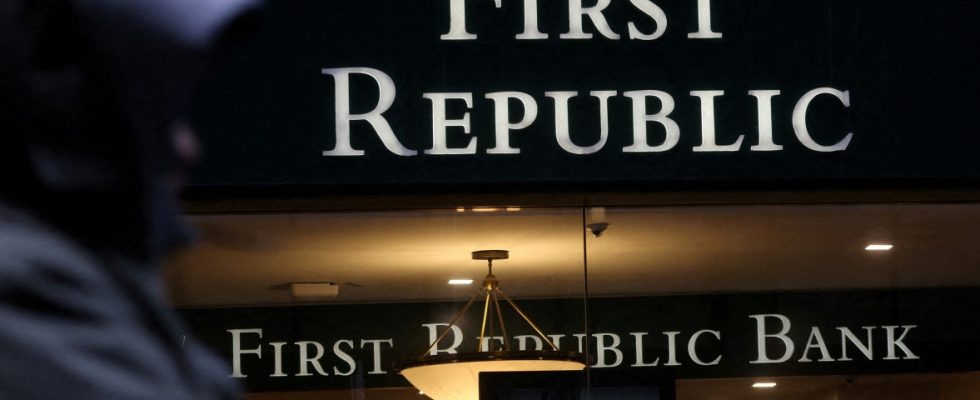It was all over after twelve minutes at the First Republic Bank in San Francisco, but that was when things really got going. The head of the ailing institute monologued for twelve minutes in a conference call on Monday about the bank’s situation, then ended the call abruptly. Questions from analysts? Not allowed. “You can now choose,” threw the voice of an announcer just behind. How friendly.
Since that failed phone call, First Republic Bank stock has plummeted 60 percent, and worries about US banking have come to the fore again. Until a few weeks ago, the US bank itself was only known to specialists overseas, but it is now the main concern on Wall Street and in Washington. Many pundits are wondering: Can the collapsing stock price cause customers to withdraw even more money?
If you want to understand that, you have to look inside the institute: Since December, customers have withdrawn massive amounts of deposits, from the 176 billion dollars that were once in the bank accounts of First Republic Bank, there are hardly any left $105 billion left. Even this figure is actually too good, because eleven major US banks parked 30 billion dollars in a bank account in March as a signal of confidence, mind you, uninsured. If these 30 billion were also deducted, the balance sheet would look far more devastating. After all, if all customers withdrew their deposits above the statutory US deposit guarantee in one fell swoop, the bank could probably pay them out based on the current status.
The bank has also taken out around 92 billion dollars in loans since the beginning of the year, mainly from the central bank. What calms you down at first glance is dangerous at second glance, because it will put the bank’s business model under pressure in the medium term: banks actually take in money from savers with comparatively low-interest accounts, while at the same time granting loans to much more generous ones Interest charges. However, if the bank now has to borrow expensive money itself, its earnings will shrink and ruin the business.
The rating agency Moody’s downgraded eleven regional banks last week, which is not a good omen for the US banking sector. Because overall it is actually becoming more and more difficult for the regional institutes to keep the savers’ money in their accounts. As early as March, many customers shifted billions to the big US banks, which the state would probably be more likely to save in the event of a financial crisis than medium-sized regional banks. In addition, there are money market funds that put investors’ money in particularly short-dated securities and promise them a return of four to five percent in the USA – better than some banks offer. In March alone, investors $367 billion pushed into these investment vehicles, a part probably simply from their bank accounts.
For the institutions, this competition for savings money is tantamount to a dilemma: If the banks want to motivate their customers to stay, they have to lure them with better interest rates. However, this puts a strain on their own business and reduces profits. Bank employees are therefore likely to take a closer look at lending in the future and avoid overly risky loans – which could ultimately have an impact on the real economy.
At the same time, many US regional banks used their loans primarily to finance real estate projects. They are particularly willing to lend money to developers of commercial real estate, i.e. project managers of new office buildings, shopping centers or hotels. Because many employees stayed in the home office after the Corona lockdowns, this market of all things is now coming under increasing pressure – and could also cause some loans from the regional banks to burst.
Experts still consider most regional banks to be stable. A stock market index of the most important US regional institutes has been around since the beginning of the year 20 percent down, but on average the institutes only lost around one percent of their deposits. Around half of special aid loans from the US Federal Reserve also went to the troubled First Republic Bank. Conversely, this means that other banks were far less affected.
However, the business figures of the First Republic Bank and the unsuccessful telephone conference have once again sown a seed of fear on the stock exchanges. If savers withdraw billions more due to the renewed price losses this week, the crisis could flare up again.
The bank tried to reassure its savers on Monday with a simple calculation: there are currently only around 20 billion dollars in savings deposits in the bank accounts, which exceed the limit of the statutory US deposit insurance. In contrast, the bank would have 45 billion in cash and unused lines of credit that it could use to pay out customers if the worst came to the worst.
Behind the scenes, however, bank leadership is working on what managers call “strategic options.” So far, many US financial politicians have been conspicuously silent when it comes to a state bailout. They apparently want other private banks to get involved in a rescue first. However, it is almost impossible that another institution wants to take over the First Republic Bank as a whole.
Observers already see this dispute between Washington and Wall Street as a “coward’s game”. Many Americans know the film adaptation of this dilemma with James Dean in “Because They Don’t Know What They Are Doing”. Two cars race towards a cliff without braking. Many are now wondering who brakes first.

